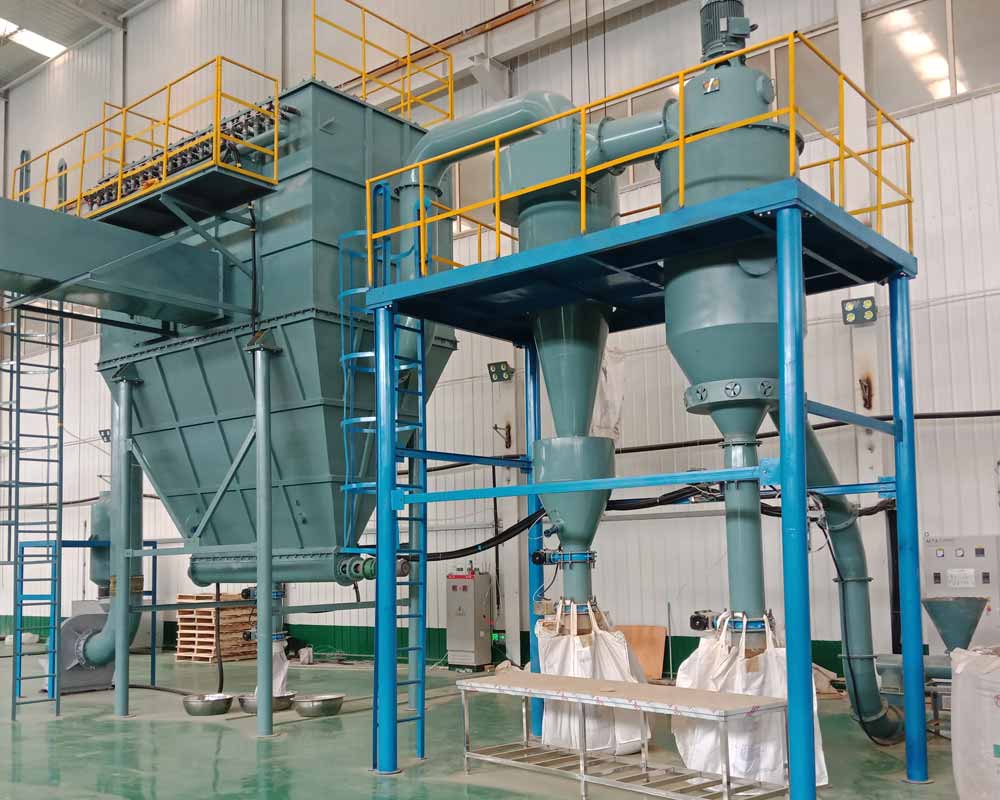Features and development direction of air classifier
Airflow classifier is a kind of equipment that uses centrifugal force of impeller rotation and drag force generated by airflow to classify materials. It is widely used in the classification and purification process of quartz, feldspar, mica, kaolin, and magnesium oxide. It has the characteristics of high classification accuracy, energy saving and high efficiency, and low production cost.
The air classifier includes a drive motor, a grading wheel, a fine powder outlet, a secondary air inlet, a raw material inlet, and a coarse powder outlet. Airflow classifier is a kind of airflow classification equipment. The classifier and cyclone separator, dust collector and induced draft fan form a set of classification system.

Under the action of the fan, the material moves to the classification area at high speed from the lower inlet of the classifier with the updraft; under the action of the strong centrifugal force generated by the high-speed rotating classification turbine, the coarse and fine materials are separated; the fine particles that meet the particle size requirements pass through The gap between the grading wheel blades enters the cyclone separator or dust collector to collect; the coarse particles entrained by the part of the fine particles hit the wall and the speed disappears, descends along the cylinder wall to the secondary air outlet, and the strong elutriation of the secondary air separates the coarse and fine particles; The fine particles rise to the classification zone for secondary classification, and the coarse particles fall to the discharge port for discharge.
| Classifier classification | Extension principle | Performance characteristics | Classification range | ||
| Static classifier | Gravity classification | Horizontal liquid type | The classification is carried out by using the difference in the trajectory and sedimentation speed of the particles in the gravity and air flow resistance. | The structure is simple, the pressure drop is small, and the processing capacity is large; the energy consumption is high, the accuracy is poor, and it is not suitable for precise classification. | Coarse grain (200-2000μm) |
| Vertical liquid type | |||||
| Inertial classification | Variable impact | Due to the different inertia of particles of different sizes, different trajectories are formed, so as to realize the classification of particles of different sizes. | The structure is simple, does not require power, and has a large processing capacity; it is not suitable for precise classification. | Larger particles (10-250μm) | |
| Attached | |||||
| Centrifugal classification | Whirlwind | Free vortex or quasi-free vortex centrifugal force interacts with air drag force in the centrifugal force field. | Simple structure, not suitable for high concentration and precise classification. | Fine particle classification (5-50μm) | |
| DS style | 1-300μm | ||||
| other | Jet | According to inertial classification, rapid classification and wall effect of fine particles, etc. | The powder is pre-dispersed well; the classification efficiency and classification accuracy are high. | Multi-level products | |
| Dynamic classifier | Transformation of the classification room | TC type | The centrifugal force and the air drag force in the forced vortex centrifugal force field. | The structure is complex and requires power; it is suitable for high concentration and precise classification. | 0.5-30μm |
| Acucut | 0.5-60μm | ||||
| Blade transformation | MP type | 2.5-60μm | |||
| MSS style | 2-30μm | ||||
| ATP type | 2-150μm | ||||
| With particle dispersion type | O-sepa style | <10μm | |||
Performance characteristics of air classifier
It is suitable for the fine classification of dry micron products. It can classify spherical, flake and irregularly shaped particles, and can also classify particles of different densities. The particle size of the classified product can reach D97:3~150μm, the product particle size is steplessly adjustable, and the variety is extremely convenient to change.
The classification efficiency (extraction rate) is 60%~90%. The classification efficiency is related to the nature of the material and the particle content that meets the particle size. The fluidity of the material is good, and the particle content that meets the particle size requirement is high, the efficiency is high, and vice versa. The speed of the grading wheel is high, and the apex is cut accurately. Multi-stage classifiers can be used in series to produce products of multiple particle sizes at the same time.
It can be used in series with ball mills, vibration mills, Raymond mills and other grinding equipment to form a closed loop. The control system adopts program control, the running status is displayed in real time, and the operation is simple and convenient.
The system runs under negative pressure, and the dust emission exceeds 40mg/m³. After adopting the noise reduction measures, the equipment operation noise is not higher than 75dB (A).
Application field
Minerals, chemicals, metallurgy, abrasives, ceramics, refractories, medicines, pesticides, food, new materials, etc., especially suitable for the classification of non-mineral products such as calcium carbonate, kaolin, quartz, talc, and mica.
The development direction of air classifier
- Large-scale and refined
With the continuous expansion of the ultra-fine powder market and the expansion of production scale, the demand for large-scale ultra-fine crushing and fine classification equipment will continue to grow. The use of large-scale equipment can reduce the energy consumption per unit product, simplify the process, reduce the area occupied, and reduce the equipment investment and production cost of the unit product.
- Vortex air classifier gradually dominates the market
The vortex air classifier is simple in structure, adjustable in particle size, and has a wide range of adaptability. It is widely used in construction, mineral processing, fine chemicals, special ceramics and other industrial fields.
- Automatic control
Industrial control automation technology is developing towards intelligence, networking and integration. The automatic control of airflow classification can improve production efficiency, reduce labor intensity of workers, and improve the overall automation level of the powder processing industry and the core competitiveness of the enterprise.
